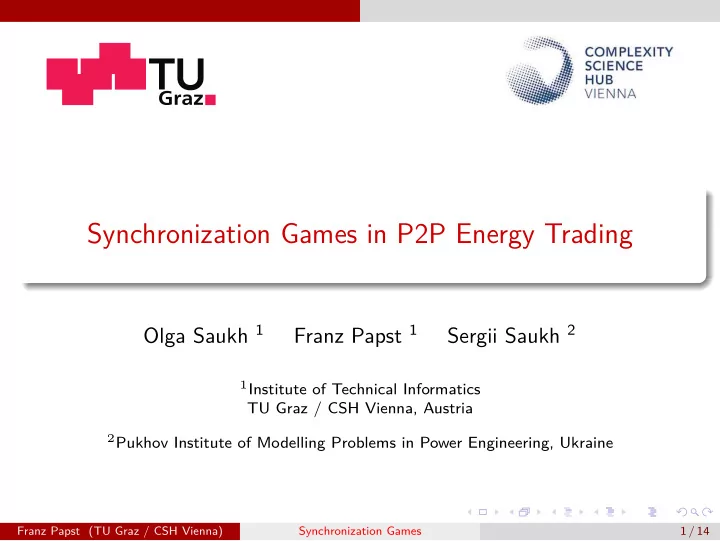

Synchronization Games in P2P Energy Trading 1 Institute of Technical Informatics TU Graz / CSH Vienna, Austria 2 Pukhov Institute of Modelling Problems in Power Engineering, Ukraine Franz Papst (TU Graz / CSH Vienna) Synchronization Games 1 / 14 Olga Saukh 1 Franz Papst 1 Sergii Saukh 2
Introduction Renewable energy sources are on the rise Topology of the power grid is changing Integration is challenging Franz Papst (TU Graz / CSH Vienna) Synchronization Games 2 / 14 ▶ from a centralized system to a decentralized one ▶ owner of the grid isn’t the only energy producer any more ▶ peer-to-peer energy trading ▶ since the grid wasn’t designed for it
Our contributions Introduce the concept of a synchronization game Show how selfjsh prosumers can utilize this concept Develop and simulate a model of synchronization games Propose methods to tackle this issue Franz Papst (TU Graz / CSH Vienna) Synchronization Games 3 / 14
Confmicting Interests Network operator vs. prosumers Source: https://goo.gl/nrXtSH Franz Papst (TU Graz / CSH Vienna) Synchronization Games 4 / 14
Confmicting Interests Trading layer vs. network layer Source: https://goo.gl/4so7gZ Franz Papst (TU Graz / CSH Vienna) Synchronization Games 5 / 14
Synchronization Games Timing is important in energy network management Network operators are constantly balancing to keep the network stable Prosumers are able to synchronize their actions with each other in order to drive the price up Synchronized behaviour corresponds to a Nash Equilibrium Franz Papst (TU Graz / CSH Vienna) Synchronization Games 6 / 14 ▶ by creating “artifjcial demand” ▶ which forces the network operator to activate backup reserves ▶ and increases the network operator’s price ▶ which then allows the prosumers to sell at higher prices
Synchronization Game Example Franz Papst (TU Graz / CSH Vienna) Synchronization Games 7 / 14
Repeated Synchronization Games Playing only one synchronization game may not be profjtable increases the energy price But playing it for multiple rounds is The prosumer has to keep the losses from purchasing energy minimal The amount of purchased energy is inversely proportional to the increase of the operator’s price Success of synchronization depends on the synchronization accuracy of the prosumers Franz Papst (TU Graz / CSH Vienna) Synchronization Games 8 / 14 ▶ because it does not necessarily mean that the network operator ▶ by decreasing the amount of purchased energy
Model Consider a microgrid ℳ with 𝑂 agents Agents can perform one action during a discrete time interval 𝑢 𝑜 Microgrid is also connected to a network operator Franz Papst (TU Graz / CSH Vienna) Synchronization Games 9 / 14 ▶ consumers ▶ prosumers ▶ using Q-learning to maximize profjts ▶ balances the system ▶ adjusts the price 𝑡 𝑢 according to the demand
Q-learning Reinforcement learning algorithm Model free Maximizes reward over all following steps States and actions are stored with their respective Q-values Q-learning gained a lot of attention recently due to Deep Q-learning Franz Papst (TU Graz / CSH Vienna) Synchronization Games 10 / 14 ▶ Q-values represent the “quality” for an action for a given state ▶ Q-values get updated each step ▶ 𝑅(𝑡 𝑢+1 , 𝑏 𝑢+1 ) = (1 − 𝛽) ⋅ 𝑅(𝑡 𝑢 , 𝑏 𝑢 ) + 𝛽 ⋅ (𝑠 𝑢 + 𝛿 ⋅ 𝑛𝑏𝑦𝑅(𝑡 𝑢+1 , 𝑏))
Simulation Simulated Microgrid Each agent has a consumption curve with two peaks per day Each prosumer has a generation curve with one peak per day Franz Papst (TU Graz / CSH Vienna) Synchronization Games 11 / 14 ▶ 5 prosumers ▶ 20 consumers ▶ 1 network operator Time interval 𝑢 𝑜 = 15 minutes ▶ between 6 and 9 AM ▶ between 4 and 8 PM ▶ between 10 AM and 6 PM
Simulation Prosumers have two actions to chose from operator) the price gets decreased by 10% Franz Papst (TU Graz / CSH Vienna) Synchronization Games 12 / 14 ▶ be “friendly” ▶ consume generated energy and sell surplus ▶ if a deal is successful the price gets increased by 10% ▶ if the price appears too high (bigger than the one from the network ▶ play a synchronization game ▶ neither earn nor lose money ▶ but the demand gets artifjcially increased ▶ network operator increases the price
Results Franz Papst (TU Graz / CSH Vienna) Synchronization Games 13 / 14
Conclusion for anomaly detection Synchronization Games Franz Papst (TU Graz / CSH Vienna) less sensitive energy price proper incentive mechanisms precise metering and real time reporting Can we prevent synchronization games? monitoring combined with machine learning algorithms What makes synchronization games possible? shortcomings like a low temporal resolution smart meters play a key role, even though they Can we detect synchronization games? software successful synchronization can be achieved by installing more active role prosumers have more infmuence on the grid due to their 14 / 14
Recommend
More recommend